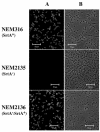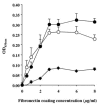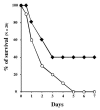The SrtA Sortase of Streptococcus agalactiae is required for cell wall anchoring of proteins containing the LPXTG motif, for adhesion to epithelial cells, and for colonization of the mouse intestine
- PMID: 15908360
- PMCID: PMC1111822
- DOI: 10.1128/IAI.73.6.3342-3350.2005
The SrtA Sortase of Streptococcus agalactiae is required for cell wall anchoring of proteins containing the LPXTG motif, for adhesion to epithelial cells, and for colonization of the mouse intestine
Abstract
Streptococcus agalactiae (group B streptococcus [GBS]) is the leading cause of neonatal pneumonia, sepsis, and meningitis. An in silico genome analysis indicated that GBS strain NEM316 encodes 35 proteins containing an LPXTG motif which are thought to be covalently linked to the peptidoglycan by an enzyme called sortase. The role of these cell wall-anchored proteins in GBS pathogenesis was evaluated on a global level by inactivating the srtA gene. This gene encodes the major sortase SrtA that anchors most of the LPXTG-containing proteins. We chose the C5a peptidase (ScpB) and Alp2, an abundant immunogenic protein, as prototypical LPXTG-containing proteins. As expected, the SrtA knockout mutant was unable to anchor the C5a peptidase (ScpB) and Alp2 to the cell wall. Complementation with plasmid-borne srtA inserted into the chromosome restored the correct surface localization of both ScpB and Alp2. Interestingly, the SrtA mutant was impaired for binding to the major extracellular matrix components fibronectin and fibrinogen and displayed a significant reduction in adherence to human (A549, HeLa, and Caco-2) and murine (L2) epithelial cells compared to the parental wild-type strain. Surprisingly, the inactivation of srtA had no effect on the virulence of the type III strain of GBS in a neonatal rat model (measured by the 50% lethal dose and lung colonization) but strongly impaired the capacity of the strain to colonize the intestines of gnotobiotic mice in a competition assay. These results demonstrate that LPXTG-containing proteins are involved in cell adhesion and GBS persistence in vivo.
Figures






Similar articles
-
Sortase A utilizes an ancillary protein anchor for efficient cell wall anchoring of pili in Streptococcus agalactiae.Infect Immun. 2008 Aug;76(8):3550-60. doi: 10.1128/IAI.01613-07. Epub 2008 Jun 9. Infect Immun. 2008. PMID: 18541657 Free PMC article.
-
A novel sortase, SrtC2, from Streptococcus pyogenes anchors a surface protein containing a QVPTGV motif to the cell wall.J Bacteriol. 2004 Sep;186(17):5865-75. doi: 10.1128/JB.186.17.5865-5875.2004. J Bacteriol. 2004. PMID: 15317792 Free PMC article.
-
Bacillus anthracis sortase A (SrtA) anchors LPXTG motif-containing surface proteins to the cell wall envelope.J Bacteriol. 2005 Jul;187(13):4646-55. doi: 10.1128/JB.187.13.4646-4655.2005. J Bacteriol. 2005. PMID: 15968076 Free PMC article.
-
Sortase-catalysed anchoring of surface proteins to the cell wall of Staphylococcus aureus.Mol Microbiol. 2001 Jun;40(5):1049-57. doi: 10.1046/j.1365-2958.2001.02411.x. Mol Microbiol. 2001. PMID: 11401711 Review.
-
Anchoring of LPXTG-Like Proteins to the Gram-Positive Cell Wall Envelope.Curr Top Microbiol Immunol. 2017;404:159-175. doi: 10.1007/82_2016_8. Curr Top Microbiol Immunol. 2017. PMID: 27097813 Review.
Cited by
-
Fhb, a novel factor H-binding surface protein, contributes to the antiphagocytic ability and virulence of Streptococcus suis.Infect Immun. 2012 Jul;80(7):2402-13. doi: 10.1128/IAI.06294-11. Epub 2012 Apr 23. Infect Immun. 2012. PMID: 22526676 Free PMC article.
-
Extracellular nucleotide catabolism by the Group B Streptococcus ectonucleotidase NudP increases bacterial survival in blood.J Biol Chem. 2014 Feb 28;289(9):5479-89. doi: 10.1074/jbc.M113.545632. Epub 2014 Jan 15. J Biol Chem. 2014. PMID: 24429288 Free PMC article.
-
Streptococcus agalactiae Non-Pilus, Cell Wall-Anchored Proteins: Involvement in Colonization and Pathogenesis and Potential as Vaccine Candidates.Front Immunol. 2018 Apr 5;9:602. doi: 10.3389/fimmu.2018.00602. eCollection 2018. Front Immunol. 2018. PMID: 29686667 Free PMC article. Review.
-
Lactobacillus fermentum ATCC 23271 Displays In vitro Inhibitory Activities against Candida spp.Front Microbiol. 2016 Oct 27;7:1722. doi: 10.3389/fmicb.2016.01722. eCollection 2016. Front Microbiol. 2016. PMID: 27833605 Free PMC article.
-
Pilus biogenesis in Lactococcus lactis: molecular characterization and role in aggregation and biofilm formation.PLoS One. 2012;7(12):e50989. doi: 10.1371/journal.pone.0050989. Epub 2012 Dec 6. PLoS One. 2012. PMID: 23236417 Free PMC article.
References
-
- Bierne, H., S. K. Mazmanian, M. Trost, M. G. Pucciarelli, G. Liu, P. Dehoux, L. Jansch, F. Garcia-del Portillo, O. Schneewind, and P. Cossart. 2002. Inactivation of the srtA gene in Listeria monocytogenes inhibits anchoring of surface proteins and affects virulence. Mol. Microbiol. 43:869-881. - PubMed
Publication types
MeSH terms
Substances
LinkOut - more resources
Full Text Sources
Other Literature Sources
Research Materials

